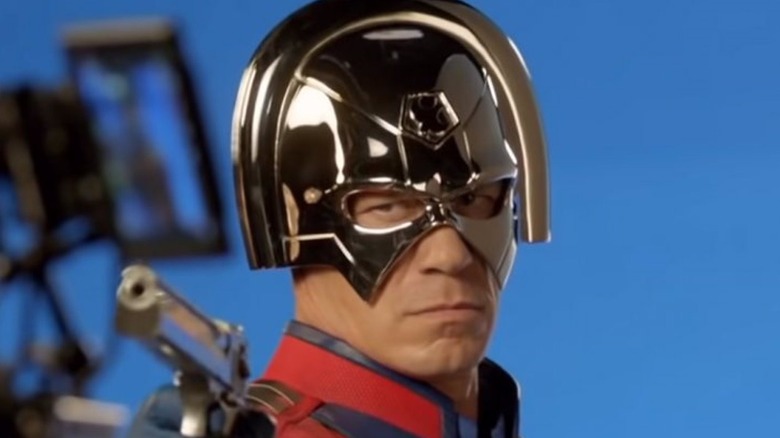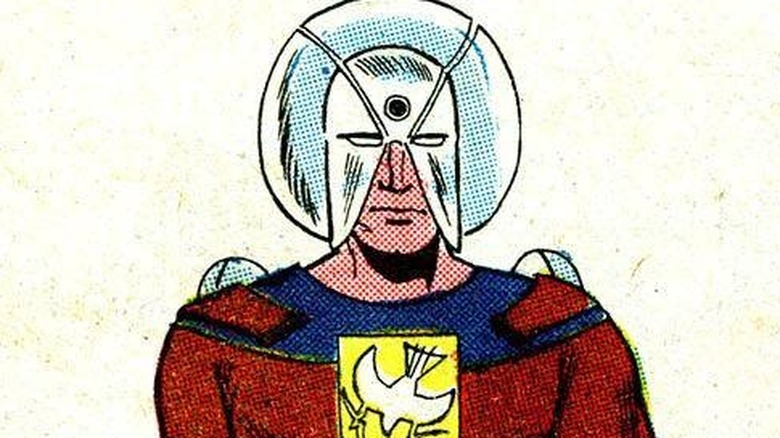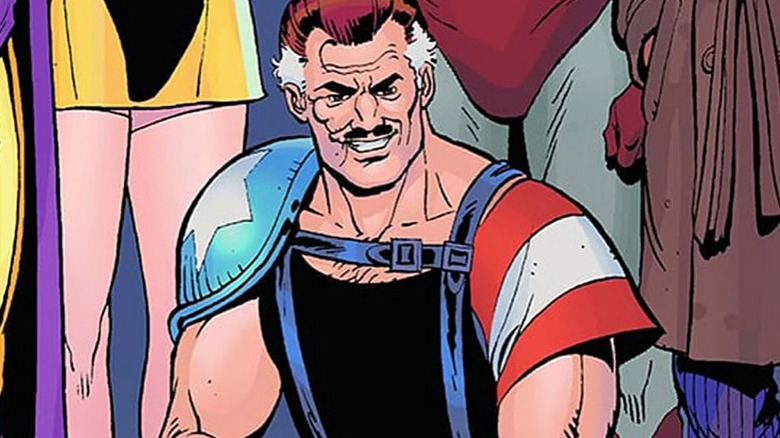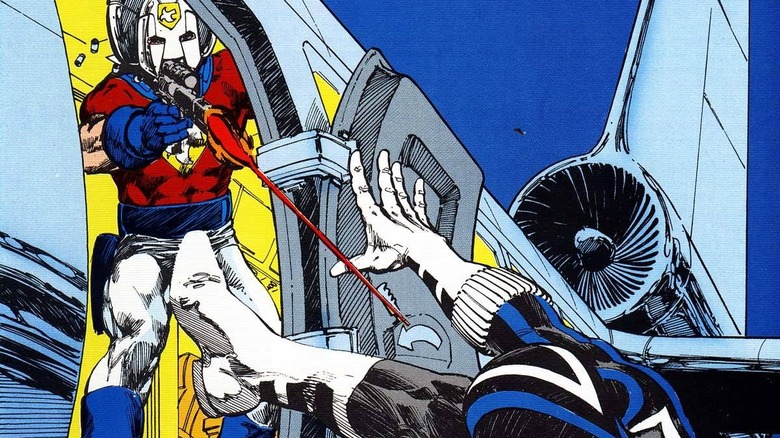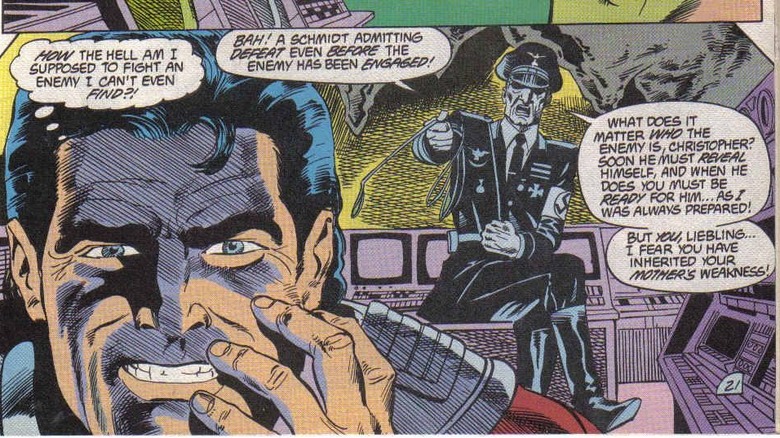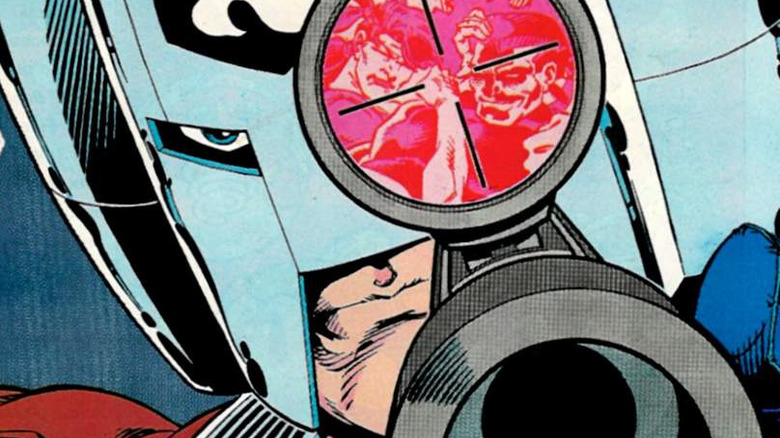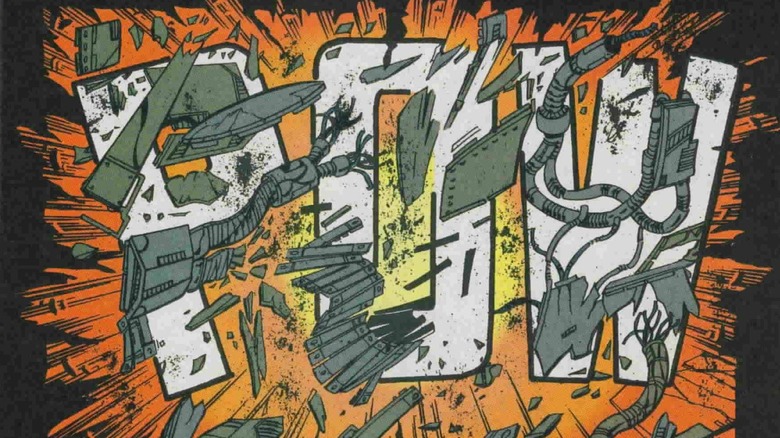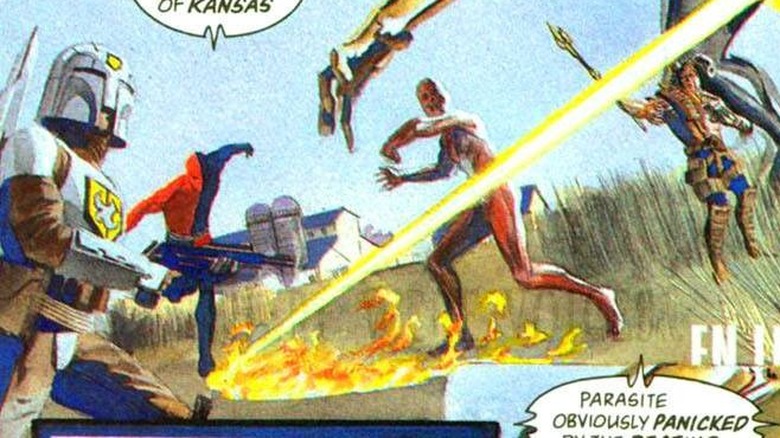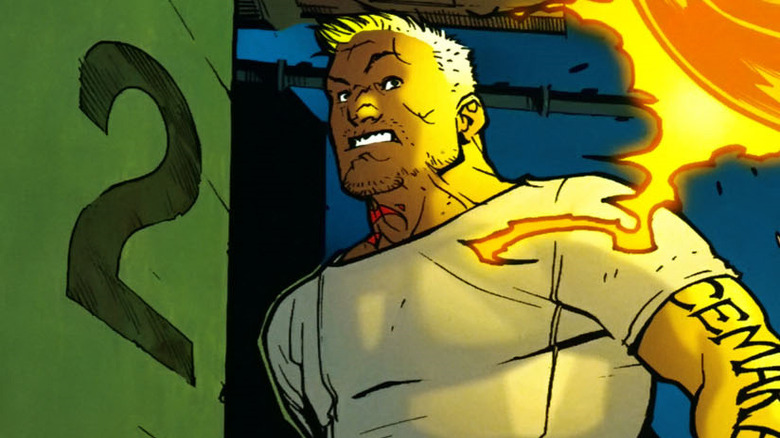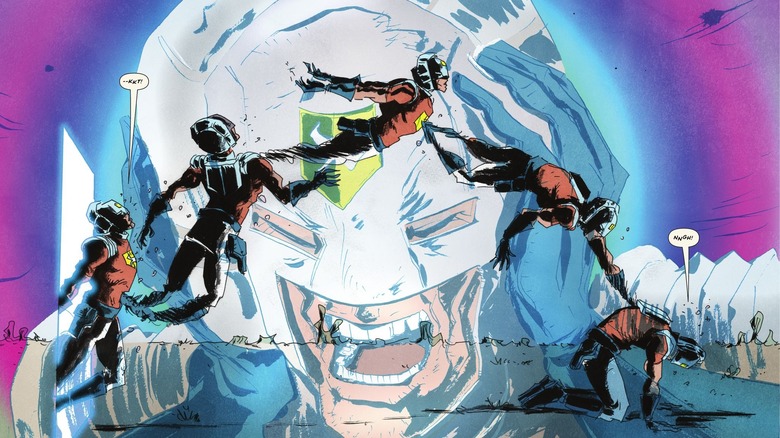The Suicide Squad: Things Only Comic Fans Will Know About Peacemaker
The casting of professional-wrestler-turned-actor John Cena as the superhero known as Peacemaker has a number of non-comics fans suddenly curious about the character. Not only does Peacemaker steal the show in the James Gunn's "The Suicide Squad," but an HBO Max series in which Cena reprises the role has already finished filming.
True to form for Gunn, whose "Guardians of the Galaxy" films made household names out of the previously obscure Marvel characters Rocket Raccoon, Groot, and Star-Lord (who?), Peacemaker is a character who's spent decades of his existence in the comics in search of a portrayal that would succeed at being both definitive and appealing to broader audiences.
Gunn seems to have succeeded where the comics have thus far fallen short — but the tortured journey of Peacemaker's publishing history makes for a fascinating story in its own right.
He got his start at Charlton Comics
The original Peacemaker was created by writer Joe Gill and artist Pat Boyette for Charlton Comics, and made his print debut as a backup feature in "Fightin' 5" #40 in November of 1966. He graduated to his own title with "Peacemaker" #1 in March of 1967 after "Fightin' 5" was canceled with issue #41. In a turnabout of fortune, the Fightin' 5 served as a backup feature in Peacemaker's title, which was itself canceled with "Peacemaker" #5 in November of 1967, although artwork has appeared online that's been attributed to Boyette, the title's penciler and inker, and was ostensibly produced for an unpublished sixth issue.
In his original incarnation, Peacemaker is Christopher Smith, a pacifist diplomat and founder of the Pax Institute who is, paradoxically, willing to use force as a superhero to try and achieve peace, although those stories note that all of his weapons are non-lethal.
Gill also co-created the Charlton Comics superheroes Captain Atom and the Judomaster, and revived an old Fox Comics superhero, the Blue Beetle, for Charlton, by co-creating the character's Silver Age incarnation, Ted Kord. It's worth noting that artist Steve Ditko, who co-created Spider-Man, not only co-created Captain Atom with Gill, but also debuted his own superhero, the Question, in the pages of Charlton Comics' "Blue Beetle" #1 in June of 1967.
He inspired Alan Moore's "Watchmen"
Around the time DC Comics acquired the aforementioned Charlton Comics superheroes in 1983, writer Alan Moore was casting about for an unused line of superheroes to reinterpret, as per his adaptation of the British "Marvelman" series. As Moore said in "The Comics Journal" #116, he recast the Charlton Comics characters in the murder-mystery he'd conceived for the MLJ's Mighty Crusaders, and submitted the story to DC managing editor Dick Giordano as "Who Killed the Peacemaker?" However, as Moore told "Entertainment Weekly," Giordano persuaded him to create romans à clef of the Charlton Comics characters that DC Comics had spent some money to acquire, because "DC realized their expensive characters would end up either dead or dysfunctional."
In Moore's "Watchmen," Peacemaker became Edward Blake, the Comedian, a government-sanctioned superhero who was active during World War II and saw combat in Vietnam, and whom Moore intended to be a "bigger, tougher" version of Watergate burglary ringleader G. Gordon Liddy. The political stridency of "Watchmen" was inspired in part by Steve Ditko, co-creator of Captain Atom and creator of the Question, because Moore was fascinated with how Ditko expressed his "very right-wing agenda" through "The Question" and "Mr. A," a "far more radical" non-Charlton superhero who Ditko also created.
Peacemaker himself appeared in the "Doomsday Clock" limited series, a "Watchmen" sequel that ran from November of 2017 to December of 2019, on page 16 of issue #9, as part of a battle against Doctor Manhattan.
He was influenced by the Comedian in turn
If DC Comics didn't want to soil their Charlton Comics purchases with "Watchmen," the success of "Watchmen" made DC more inclined to reflect Moore's revisions to those characters in their original Charlton incarnations. For example, after DC gave the Question his own series in 1987, "The Question" #17 saw the title character read an issue of "Watchmen" and become impressed by the character of Rorschach. After the Question was beaten up trying to emulate Rorschach, he changed his mind, and decided, "Rorschach sucks."
But Peacemaker's debut in the DC universe — after "Crisis on Infinite Earths" #6, where he and Captain Atom made their first DC appearances — went further than Moore's deconstruction of the character as the Comedian in "Watchmen," thanks to writer Paul Kupperberg. DC began publishing "Vigilante" in November of 1983, starring district attorney Adrian Chase as the anti-heroic title character who takes the law into his own hands after his wife and children are killed by mobsters. Kupperberg took over as the title's writer with issue #16.
Kupperberg used his run to introduce Peacemaker to the DC universe with a three-issue arc, running from "Vigilante" #36 to #38, that saw Peacemaker murder David Winston, Adrian Chase's successor as the Vigilante, before he defeated and unmasked Chase as the Vigilante live on television.
He talks to ghosts through his helmet
Peacemaker returned as an antagonist to Chase in "Vigilante" #41 to #43, again written by Kupperberg, and as a flashback cameo in Kupperberg's "Vigilante" #50, the final issue of the series in February of 1988. At that point DC simply handed Kupperberg his own four-issue "Peacemaker" miniseries, which ran from January through April of 1988.
What Kupperberg established, over the course of his "Vigilante" and "Peacemaker" issues, was that the Christopher Smith of the DC universe was willing to kill for peace, not just fight for it, and that even before he became Peacemaker, he wound up orchestrating a Mỹ Lai-esque massacre as a U.S. Army enlistee in the Vietnam war. In committing such acts of brutality, Smith was urged on by what he saw as the ghost of his father, Austrian industrialist Wolfgang Schmidt, whose own war crimes included commanding a Nazi concentration camp in Poland.
Smith was pardoned by the U.S. government to work for its Project: Peacemaker program, and used the proceeds from his father's business to start the Pax Institute in Geneva as a charity, to aid the victims of war. And yet, as what Smith perceived to be his father's spirit kept bullying him to become ever more extreme in his violence, he began to believe that the souls of those he could not save lived on in his helmet.
So, yes, Peacemaker talks to the ghosts he thinks are living inside his helmet.
"The Wall" was his boss, but not on the Squad
From there, Christopher Smith passed through more hands than a broken toy in a daycare playroom, as the generically shadowy Agency (really, that was its full name) overseeing Project: Peacemaker was reorganized as Checkmate by order of Amanda Waller (played by Viola Davis in 2016's "Suicide Squad" and 2021's "The Suicide Squad").
"The Wall" was technically part of Peacemaker's chain of command until "The Janus Directive," an 11-part crossover that ran from May to June of 1989. Peacemaker appeared in "Checkmate" #16 to #18, and "Suicide Squad" #27 to #30. In the story, Waller convenes the agencies under the control of Task Force X — the Suicide Squad, Checkmate and Project: Peacemaker — to inform them of "The Janus Directive," a conspiracy against rival American intelligence agencies. Inter-agency chaos and backstabbing galore ensues, we learn Waller was replaced by a doppelganger for some, but not all, of the time she was presumed to have gone rogue, and then-President George H.W. Bush personally dissolves Task Force X. Comics, everybody!
Even though Peacemaker is sent to abduct and/or assassinate a couple of folks over at Project: Atom, he doesn't put in an appearance in the title of his Charlton Comics cohort, "Captain Atom" #30, which was also the concluding issue of "The Janus Directive. In the comics, Peacemaker wasn't depicted as a member of the Suicide Squad until March 2021, when he was shown breaking into Arkham Asylum in "Infinite Frontier" #0, and was featured as a central character in the first issue of the new "Suicide Squad" series.
The Death (and Afterlife) of Christopher Smith
When enough failed attempts have been made to try and make a comic book character happen, someone in the editorial bullpen will suggest killing them off to generate sales. Following the successful "The Death of Superman" crossover, which ran from December of 1992 to October of 1993, DC decided to get rid of much of its dross at once, via the villain Eclipso.
Eclipso was a body-hopping demon whose 1992 miniseries and crossover, "Eclipso: The Darkness Within," pitted him against the assembled heroes of the DC universe. He spent his subsequent ongoing series conquering the fictional South American country of Parador via possession, one person at a time, until Amanda Waller and the "Shadow Fighters" stepped up to stop him. The team's lineup included Peacemaker, the Steve Ditko co-created character Creeper, Justice Society member Commander Steel, and Infinity Inc. members Doctor Midnight and Wildcat (Yolanda Montez, now appearing in the live-action "Stargirl" TV series).
The Shadow Fighters assembled in "Eclipso" #11 in September of 1993, and disbanded in "Eclipso" #13 in November of 1993 after seven of the team's 14 members were killed by Eclipso, including everyone mentioned above, save for "The Wall." And while death is often a revolving door in comics, Christopher Smith stayed dead long enough for his soul to appear in Purgatory in the "Day of Judgment" miniseries and crossover that ran through November of 1999. In that arc, Earth's heroes attempt to recruit former Green Lantern Hal Jordan from Purgatory to become the new Spectre. Peacemaker helps by working with the other dead vigilantes in Purgatory to weaken its guardians' hold on Jordan's soul.
The Legion of Substitute Peacemakers
Less than a year after Christopher Smith was killed by Eclipso, DC apparently decided the Peacemaker brand name was too valuable to lie fallow. The 1994 "Judgment Day" crossover between the three Justice League titles published at the time introduced a new Peacemaker, whose "secret identity" was kept secret even from the readers, as a member of the "League Busters," a United Nations-sanctioned group assembled to take down the Justice League International. This Peacemaker and the League Busters only appeared in two issues, and were never seen again.
Another Peacemaker appears in the 1996 four-issue "Kingdom Come" miniseries, by writer Mark Waid and artist Alex Ross, where Peacemaker and his fellow Charlton Comics heroes are recast as members of the anti-heroic Magog's Justice Battalion, all of whom appear to be killed when Captain Atom explodes. Visually, Ross' version of Peacemaker pairs the character's traditional helmet with an outfit that's clearly evocative of Boba Fett's armor from "Star Wars," long before audiences had another Mandalorian to root for.
Surgeon Mitchell Black, who lost his medical license after his untried operating techniques led to the death of a young patient, was recruited by the Geneva-based "Peacemaker Project," to head up its enforcement division of golden-armored, nanite-equipped Peacemakers, who were dispatched to trouble-spots around the globe. Along with DC's other Charlton Comics heroes, Black joined "The L.A.W. (Living Assault Weapons)," whose six-issue series ran from September of 1999 to February of 2000, before he was killed by the villain Prometheus in "Infinite Crisis" #7, published in April of 2006.
He mentored the current Blue Beetle:
After teenager Jaime Reyes was introduced as the Blue Beetle in "Infinite Crisis," a new "Blue Beetle" title premiered in May 2005. That July, a helmetless Peacemaker joined the series' cast. He went by "Mitchell Black," before settling on "Christopher Smith," even though he was inexplicably resurrected and more mentally stable than the man he claimed to be.
Peacemaker wanted to see if the new Blue Beetle was a threat after learning how the technology that empowered Jaime Reyes made humans susceptible to the control of the alien race known as "The Reach." However, after the Reach realized they couldn't control Jaime through his cybernetic implant, they implanted a scarab in Peacemaker to control him. After Peacemaker received a Yellow Lantern Power Ring as a member of the Sinestro Corps, the Reach sent him to kill Jaime, but Jaime helped him face his fears, and Peacemaker summoned the courage to cut the scarab from his body.
Peacemaker went from a grudging partner to a gruff but well-meaning mentor to Jamie, as well as a fiercely loyal defender of the Reyes family. In "Blue Beetle" #36, the final issue of the series, Peacemaker bids farewell to Jaime by encouraging him to become his own man. This Peacemaker returned in "Final Crisis Aftermath: Escape" #3 and #4, as a detainee and prospective recruit of the Global Peace Agency, while his mentorship of Jaime Reyes was referenced in "Young Justice" #20 — spun off from the animated TV series — where Peacemaker vouches for Jaime by telling Nightwing he's "a good kid."
He's been feeling a touch of "Vertigo" recently
As one would expect from the publisher that followed Alan Moore's output on "Watchmen" and "(The Saga of the) Swamp Thing" with countless "mature readers" revamps of Golden, Silver and Bronze Age characters through its Vertigo imprint, DC has subjected Peacemaker to no shortage of in-story strangeness. On the lighter side, Keith Giffen included Peacemaker as a backup feature in the first five issues of his "Inferior 5" limited series, which launched in November of 2019 but didn't conclude until issue #6 in June of 2021 — where Peacemaker was promoted to the main story — due to publication delays caused by the COVID-19 pandemic.
And as has been DC's strategy so often over the years, when in doubt, hand it over to writer Grant Morrison and let him do something weird with it. The final issue of the year-long weekly "52" limited series introduced "Earth-4," a world inhabited by even more overtly "Watchmen"-inspired versions of the Charlton Comics heroes. Morrison revisited this post-"52" Earth-4 in "The Multiversity: Pax Americana," published in November of 2014, where a genuinely heroic Peacemaker saves the life of President George W. Bush when terrorists break into the White House, and then saves the world from the threat of superheroes themselves by assassinating a fictional president.
Whatever strangeness or other developments might ensue for the character next, it's all likely to depend on how well James Gunn's "Peacemaker" series is received by the public.
